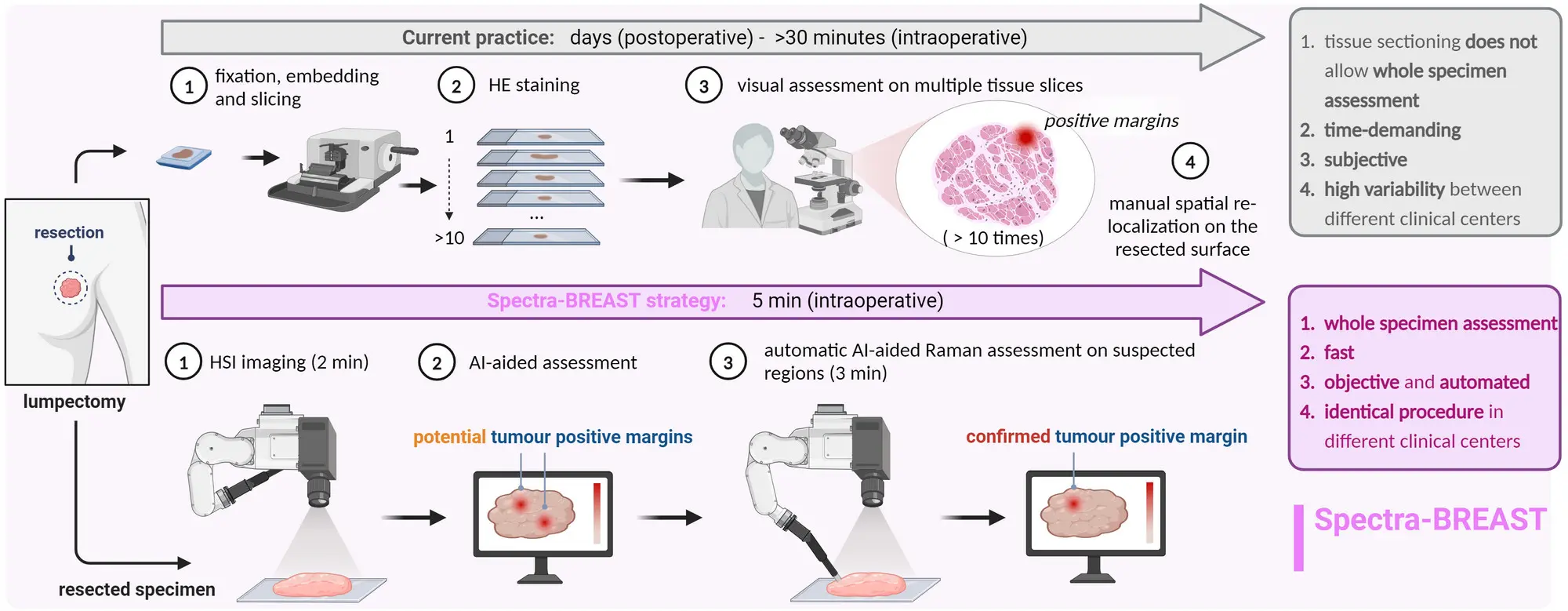Start
01/12/2024
End
30/11/2028
Status
In progress
Spectra-BREAST
Website's ProjectStart
01/12/2024
End
30/11/2028
Status
In progress
Spectra-BREAST
Website's Project
Optical techniques to improve breast-conserving surgery
Breast-conserving surgery (a lumpectomy) is meant to remove the cancer while leaving as much of the breast as possible. Defining the tumour margin to ensure the cancer is completely removed is currently done primarily post-operatively, resulting in approximately one in five patients requiring a second surgery. Funded by the European Innovation Council, the Spectra-BREAST project aims to revolutionise breast-conserving surgery by providing a tool to assess tumour margins during surgery with over 95 % accuracy and in under five minutes. Combining hyperspectral imaging, Raman spectroscopy and AI, it will identify cancerous tissue up to two millimetres deep, improving patient outcomes, reducing healthcare costs and enabling broader applications in other cancer surgeries and biopsies.
Project Objective
The Spectra-BREAST project aims to revolutionize the assessment of tumor resection margins during breast conserving surgery (BCS). Currently, approximately 20% of breast cancer patients require a second operation due to incomplete removal of cancerous tissue. This results in increased costs for the healthcare system and significant negative effects on patients’ well-being.
Nowadays, the standard margin assessment procedure is postoperative histopathological specimen analysis, which takes several days to complete. Although intraoperative histopathological analysis on frozen tissue is possible, it is less effective and cannot be implemented in all clinical centers. Alternative techniques have been suggested but have low diagnostic performance or take excessive time to assess the entire resected specimen.
Spectra-BREAST aims to support surgeons with an intraoperative tool providing accurate and actionable feedback on the resection margin status over the whole specimen in less than 5 minutes. To this end, we will apply a radically new, high-risk multimodal approach combining two optical techniques, Hyperspectral Imaging (HSI) and fiber-optic Raman Spectroscopy (RS) with AI-based data-analysis. HSI and AI will be used for fast and sensitive detection of suspicious margins, which are subsequently analyzed by RS, and a second AI will make the final prediction on the RS spectra. The ambition is to identify tumors on and below the resection surface (up to a depth of 2 mm), with an unprecedented high sensitivity and specificity (over 95%) in real-time. Spectra-BREAST also has the potential for wider applications, going beyond breast cancer to include margin assessment for other cancers, robotic/laparoscopic surgery, and guided biopsy.
Finally, Spectra-BREAST will offer an objective technology reducing variability between patients, and most importantly, will improve patient outcomes such as reduced hospital stays, complications, anxiety, and improved cosmetic outcomes
Research labs
VIBRA
Find out more